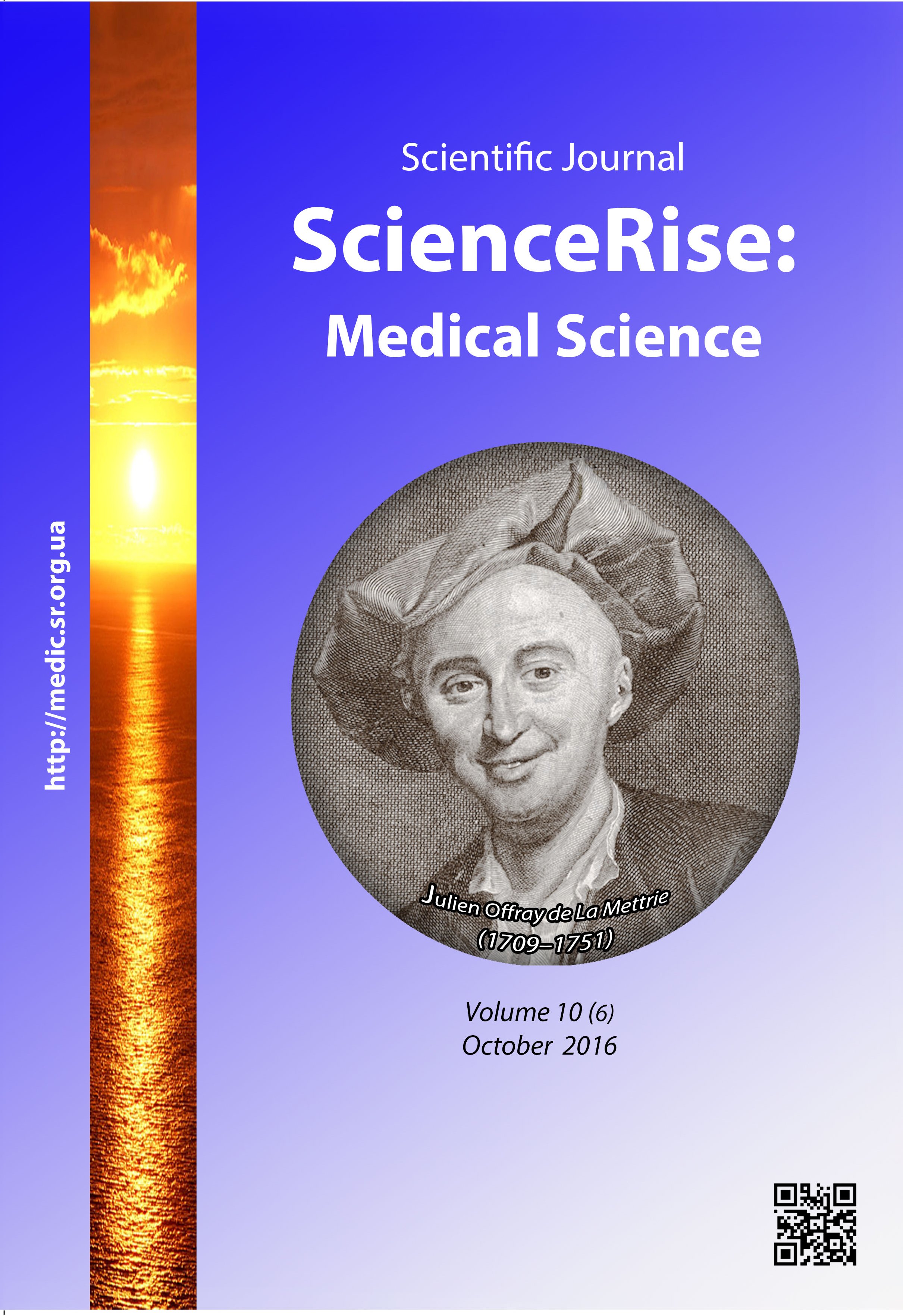The use of remote infrared thermography in the diagnostics of acute paranasal sinusitis
DOI:
https://doi.org/10.15587/2519-4798.2016.80545Keywords:
diagnostics of sinusitis, remote infrared thermography, paranasal sinuses, acute sinusitis, thermogram, thermoasymmetryAbstract
Aim of research. The improvement of the quality of diagnostics in patients with acute paranasal sinusitis, based on the remote infrared thermography.
Materials and methods. 300 patients were examined. Among them: patients with acute paranasal sinusitis – 200 persons and control group – 100 persons. These data are based on the result of analysis of thermographic examination of patients with acute paranasal sinusitis. The age of patients varied within 19–91years.
RIT was realized in all thematic patients and control group, using thermograph of 3 generation on the base of microbolometric matrix with format 384х288 elements with inserted screen.
Examination and treatment was carried out on the clinical base of otolaryngology department of KNMU: in ENT department and polyclinic of Kharkiv regional hospital from 2015 to 2016 inclusive.
Results. The distribution of parameters of the remote infrared thermography of paranasal sinuses in practically healthy people was established depending on age and sex. At that the thermoasymmetry was not more than 0,4 °С (р<0,05).
At interpretation of thermographic picture at the catarrhal, serous and purulent sinusitis we revealed that the temperature parameters are raised in projection of pathological process statistic reliability.
At the acute catarrhal sinusitis – Т=34,6±0,7 °С, where êТ=0,4–0,9 °С, serous – Т=34,3±0,5 °С, where êТ=1,0–1,4 °С, acute purulent – Т=34,6±0,85 °С, where êТ=1,5–2,5 °С.
Conclusions. Thus, using the data of infrared thermography, received at analysis of thermograms of practically healthy people and patients with problems in projection of paranasal sinuses, the early diagnostics of the acute inflammatory process in nasal sinuses can be realized
References
- Vainer, B. G. (2004). Matrichnoe teplovidenie v fiziologii: issledovanie sosudistykh reaktsii, perspiratsii i termoregulyatsii u cheloveka. Novosibirsk: Izdatel'stvo Sibirskogo otdeleniya RAN, 96.
- Venger, Je. F., Dunajevs'kyj, V. I., Kolljuh, O. G. et. al. (2006). Teplovizijna diagnostyka rann'ogo vyjavlennja zahvorjuvan' ljudyny. Jelektronika i svjaz', 79–83.
- Durnovo, E. A., Potekhina, Yu. P., Khomutinnikova, N. E., Yanova, N. A. (2012). Vozmozhnosti infrakrasnoi termografii v kompleksnoi diagnostike zabolevanii chelyustno-litsevoi oblasti. Sovremennye problemy nauki i obrazovaniya, 4. Available at: http://www.science-education.ru/104-6657
- Park, J. V., Kim, S. H., Lim, D. J. et. al. (2003). The role of thermography in clinical practice: review of the literature. Thermology International, 13, 77–78.
- Ring, E. F. J. (2006). The historical development of thermometry and thermal imaging in medicine. Journal of Medical Engineering & Technology, 30 (4), 192–198. doi: 10.1080/03091900600711332
- Zabolotnyi, D. I., Rozenfel'd, L. G., Kolotilov, N. N. et. al. (2006). Novye vozmozhnosti distantsionnoi infrakrasnoi termografii v otorinolaringologii. Zhurnal vushnikh, nosovikh і gorlovikh khvorob, 5, 2–5.
- Rozenfel'd, L. G., Kolotilov, N. N., Zabolotnaya, D. D. et. al. (2006). Pervyi opyt primeneniya otechestvennogo distantsionnogo infrakrasnogo termografa s matrichnym fotopriemnikom v otorinolaringologii. Zhurnal vushnikh, nosovikh і gorlovikh khvorob, 5, 135–136.
- Ammer, K. (2004). A computer-assisted literature survey with a focus on nonmedical applications of thermal imaging. Thermol. Int., 14 (1), 5–36.
- Zajac, G. A., Koval', V. T. (2010). Medicinskoe teplovidenie – sovremennyj metod funkcional'noj dіagnostiki. Zdorov'e. Medicinskaja jekologija. Nauka, 43 (3), 27–33.
- Mitin, Yu. V., Rozenfel'd, L. G., Podvornyi, V. N. (1994). Neioniziruyushchie metody luchevoi diagnostiki zabolevanii okolonosovykh pazukh. Kiev, 112.
- Rozenfel'd, L. G., Dekhtyarev, Yu. P., Mironenko, S. A. et. al. (2011). Teplovizionnaya diagnostika v otsenke sostoyaniya zdorov'ya molodezhi v vozraste ot 16 do 25 let. Elektronika i svyaz'. Tematicheskii vypusk «Elektronika i nanotekhnologii». Biomeditsinskie pribory i sistemy, 4, 122–125.
- Bichinho, G. L., Gariba, M. A., Sanches, I. J., Gamba, H. R., Cruz, F. P. F., Nohama, P. (2007). A Computer Tool for the Fusion and Visualization of Thermal and Magnetic Resonance Images. Journal of Digital Imaging, 2 2(5), 527–534. doi: 10.1007/s10278-007-9046-3
- Head, J. F., Elliott, R. L. (2002). Infrared imaging: making progress in fulfilling its medical promise. IEEE Engineering in Medicine and Biology Magazine, 21 (6), 80–85. doi: 10.1109/memb.2002.1175142
- Sergeev, S. V., Grigor'kina, E. S. (2013). Matematicheskaya model' vozrastnykh parametrov khirurgicheskoi anatomii verkhnechelyustnoi pazukhi. Rossijskaja otorinolaringologija, 6, 114–118.
- Sergeev, S. V., Grigor'kina, E. S., Smogunov, V. V. et. al. (2014). Kompleksnoe primenenie termografii i mestnoi termometrii v diagnostike, prognozirovanii, modelirovanii techeniya i otsenke effektivnosti lecheniya ostrogo sinusita. Vestn. Otorinolaringologii, 5, 52–54.
- Shusharin, A. G., Morozov, V. V., Polovinka, M. P. (2011). Meditsinskoe teplovidenie – sovremennye vozmozhnosti metoda. Sovremennye problemy nauki i obrazovanija, 4. Available at: http://www.science-education.ru/ru/article/view?id=4726
Downloads
Published
How to Cite
Issue
Section
License
Copyright (c) 2016 Олександр Олександрович Карчинський, Анатолій Семенович Журавльов, Юлія Вікторівна Фоменко, Євгенія Вікторівна Дьоміна

This work is licensed under a Creative Commons Attribution 4.0 International License.
Our journal abides by the Creative Commons CC BY copyright rights and permissions for open access journals.
Authors, who are published in this journal, agree to the following conditions:
1. The authors reserve the right to authorship of the work and pass the first publication right of this work to the journal under the terms of a Creative Commons CC BY, which allows others to freely distribute the published research with the obligatory reference to the authors of the original work and the first publication of the work in this journal.
2. The authors have the right to conclude separate supplement agreements that relate to non-exclusive work distribution in the form in which it has been published by the journal (for example, to upload the work to the online storage of the journal or publish it as part of a monograph), provided that the reference to the first publication of the work in this journal is included.









